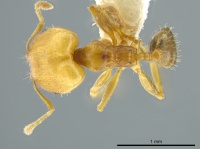Pheidole daphne
| Pheidole daphne | |
|---|---|

| |
| Scientific classification | |
| Kingdom: | Animalia |
| Phylum: | Arthropoda |
| Class: | Insecta |
| Order: | Hymenoptera |
| Family: | Formicidae |
| Subfamily: | Myrmicinae |
| Tribe: | Attini |
| Genus: | Pheidole |
| Species: | P. daphne |
| Binomial name | |
| Pheidole daphne Wilson, 2003 | |
Colonies of daphne are arboricolous, and as such have been collected by insecticidal fogging and Malaise trapping in lowland rainforest (Longino 1997).
Identification
See the description in the nomenclature section.
Keys including this Species
Distribution
The Atlantic lowlands of Costa Rica (Longino 1997).
Latitudinal Distribution Pattern
Latitudinal Range: 21.3° to 10.35°.
| North Temperate |
North Subtropical |
Tropical | South Subtropical |
South Temperate |
- Source: AntMaps
Distribution based on Regional Taxon Lists
Neotropical Region: Costa Rica (type locality).
Distribution based on AntMaps
Distribution based on AntWeb specimens
Check data from AntWeb
Countries Occupied
| Number of countries occupied by this species based on AntWiki Regional Taxon Lists. In general, fewer countries occupied indicates a narrower range, while more countries indicates a more widespread species. |

|
Estimated Abundance
| Relative abundance based on number of AntMaps records per species (this species within the purple bar). Fewer records (to the left) indicates a less abundant/encountered species while more records (to the right) indicates more abundant/encountered species. |

|
Biology
Castes
Worker
Minor
Images from AntWeb
    
| |
| Worker. Specimen code inbiocri001231279. Photographer J. Longino, uploaded by University of Utah. | Owned by INBio. |
Major
Images from AntWeb

| |
| Worker (major/soldier). Specimen code inbiocri001230999. Photographer J. Longino, uploaded by University of Utah. | Owned by INBio. |
Nomenclature
The following information is derived from Barry Bolton's Online Catalogue of the Ants of the World.
- daphne. Pheidole daphne Wilson, 2003: 404, figs. (s.w.) COSTA RICA.
Unless otherwise noted the text for the remainder of this section is reported from the publication that includes the original description.
Description
A medium-sized, distinctively bicolorous member of the flavens group, similar to the widespread species Pheidole bilimeki, differing in the major by the laterally angulate (as opposed to spinose) postpetiolar node, limited shagreening on the first gastral tergite, and color (see below); and in the minor by the completely smooth and shiny first gastral tergite.
MEASUREMENTS (mm) Holotype major: HW 0.90, HL 0.90, SL 0.50, EL 0.12, PW 0.42. Paratype minor: HW 0.46, HL 0.56, SL 0.46, EL 0.08, PW 0.30.
COLOR Major: head and appendages clear medium yellow, except for an ill-defined light brown circular spot in center of head capsule dorsum; rest of body (mesosoma, waist, gaster) light brown.
Minor: head and gaster light brown, rest of body and appendages medium to dark yellow.
Figure. Upper: holotype, major. Lower: paratype, minor. Scale bars = 1 mm.
Type Material
COSTA RICA: La Selva Biological Station, near Puerto Viejo, Heredia, 50–150 m, col. J. T. Longino. Instituto Nacional de Biodiversidad
Etymology
Named after Daphne, the nymph in classical mythology who was changed into a laurel tree (reference to the arboricolous habits of the species).
References
- Wilson, E. O. 2003. Pheidole in the New World: A dominant, hyperdiverse ant genus. Harvard University Press, Cambridge, MA. (page 404, fig. major, minor described)


